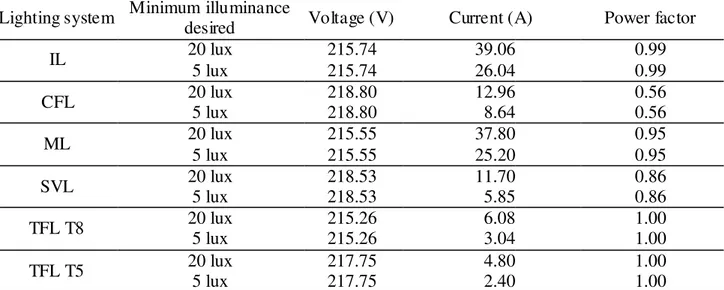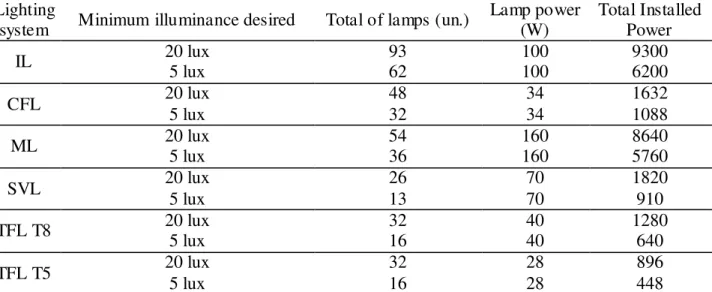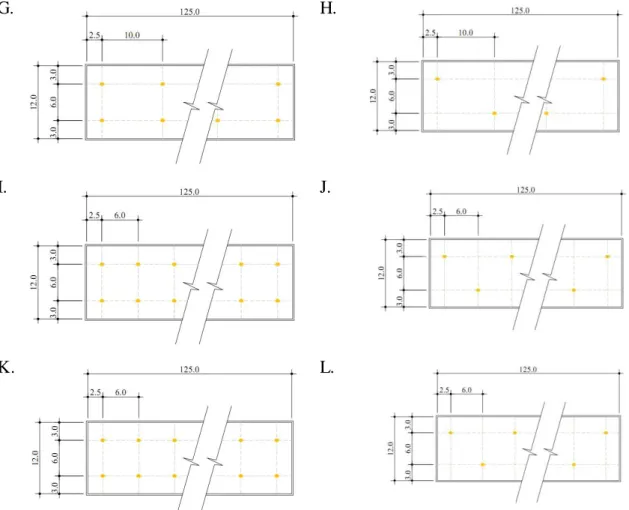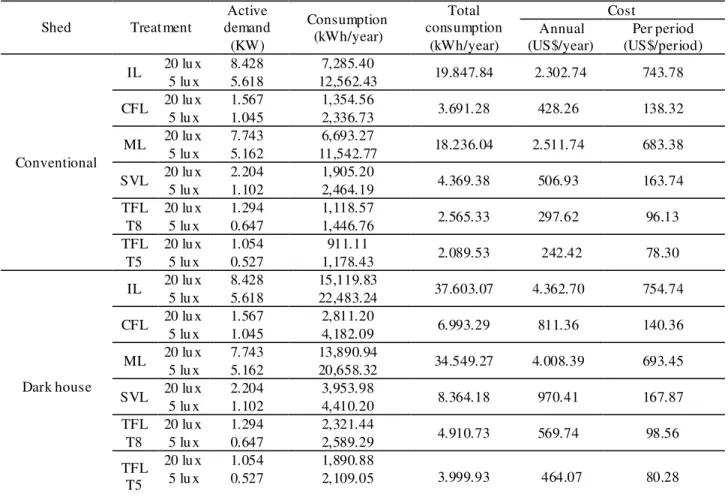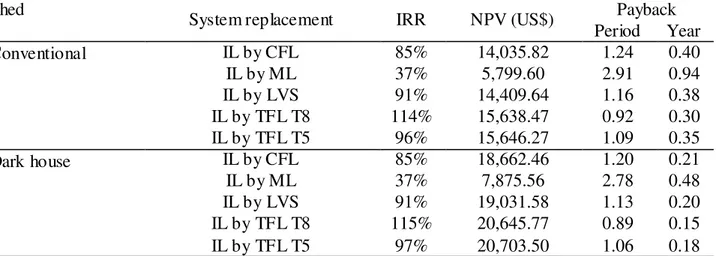ISSN: 1809-4430 (on-line)
_________________________
1 Arquiteta, Profa. Doutora, Departamento de Engenharia, UFLA/Lavras – MG, Fone: (35) 3829-2010, priscilla.ribeiro@deg.ufla.br 2 Engº Agrícola, Prof. Doutor, Departamento de Engenharia, UFLA/Lavras – MG, yanagi@deg.ufla.br
3 Engº Eletricista, Prof. Doutor, Departamento de Ciências Exatas, UFLA – MG, joaquim@dex.ufla.br 4 Meteorologista, Profa. Doutora, Departamento de Engenharia, UFLA/Lavras – MG, silvia.yanagi@deg.ufla.br
5 Administrador, Prof. Doutor, Departamento de Administração e Economia, UFLA/Lavras – MG, renato.campos@dae.ufla.br TECHNICAL-ECONOMIC ANALYSIS OF DIFFERENT LIGHTING SYSTEMS FOR
BROILER POULTRY Doi:http://dx.doi.org/10.1590/1809-4430-Eng.Agric.v36n2p 242-252/2016
PRISCILLA A. P. RIBEIRO1, TADAYUKI YANAGI JUNIOR2,
JOAQUIM P. DA SILVA3, SÍLVIA DE N. M. YANAGI4, RENATO S. CAMPOS5
ABSTRACT: Broiler poultry is highly dependent on artificial lightening. Power consumption costs of artificial lighting systems is the second largest expense related to broiler industry, second only to feed expenses. Therefore, the current study focused to analyze technical and economic feasibility of replacing incandescent lamps already used in aviaries with other lamp types. Costs related to power consumption, implementation and maintenance of the lighting systems were evaluated with the aid of financial mathematics using net present value, return over investment and payback. Systems composed of six lamp types were analyzed in two different configurations to meet the minimum illuminance of 5 and 20 lux and for use in conventional sheds and dark house. The lamps tested were incandescent (LI) of 100 W, compact fluorescent (CFL) of 34 W, mixed (ML) 160 W sodium vapor (SVL) of 70 W, tubular fluorescent T8 (TFL T8) of 40 W and tubular fluorescent T5 (TFL T5) of 28 W. For the systems tested, it was found that the tubular fluorescent lamps T8 and T5 showed the best results of technical and economic feasibility.
KEYWORDS: Economic analysis, Poultry farming, Energy efficiency, Artificial lighting.
ANÁLISE TÉCNICO-ECONÔMICA DE DIFERENTES SISTEMAS DE ILUMINAÇÃO PARA AVIÁRIOS DE FRANGOS DE CORTE
RESUMO: A produção de frangos de corte é altamente dependente do uso de luz artificial. O custo do consumo de energia elétrica do sistema de iluminação artificial constitui a segunda maior despesa relacionada à produção de frangos de corte, inferior apenas às despesas com ração. Portanto, objetivou-se com o presente trabalho analisar a viabilidade técnico-econômica de se substituir a lâmpada incandescente utilizada nos aviários por outros tipos de lâmpada. O consumo de energia e os custos de implantação e de manutenção dos sistemas de iluminação foram avaliados com auxílio da matemática financeira, por meio do valor presente líquido, da taxa de retorno do investimento e do tempo de retorno do capital (payback). Foram avaliados sistemas compostos por seis tipos de lâmpada, em duas configurações diferentes, para atender às iluminâncias mínimas de 5 e 20 lux e para a utilização em galpões convencionais e dark house. As lâmpadas testadas foram a incandescente (LI) de 100 W, a fluorescente compacta (LFC) de 34 W, a mista (LM) de 160 W, o vapor de sódio (LVS) de 70 W, a fluorescente tubular T8 (LFT T8) de 40 W e a fluorescente tubular T5 (LFT T5) de 28 W. Para os sistemas testados, verificou-se que as lâmpadas fluorescentes tubulares T8 e T5 apresentaram os melhores resultados de viabilidade técnica e econômica.
PALAVRAS-CHAVE: análise econômica, avicultura, eficiência energética, iluminação artificial.
INTRODUCTION
and health and environment care. Lighting is one of the environmental factors that interfere with the performance of poultry activity, for houses must be properly lit to reduce cannibalism, bird movement and electricity costs (MENDES et al., 2010). The light does not allow only viewing for birds, but it also influences the physiological, reproductive and behavioral activities. Proper lighting manipulation involves the amount of light (time and intensity), light color (or wavelength) and spectral frequency (GONGRUTTANANUN & GUNTAPA, 2012).
Due to the economic importance of the poultry industry and the demands of the foreign market, there are aspects that require development, such as electricity consumption and activity sustainability. Electricity used in aviaries for broiler chickens aimed at feeding, maintenance of the thermal environment within appropriate limits and lighting is extremely important in the quantification of production costs and the cost/benefit ratio (BUENO & ROSSI, 2006).
In the poultry production chain, electricity costs are the second largest expense, second only to feed. Total spending and waste of electricity in poultry production are high. Thus, studies that modify and update poultry sectors are required, enabling the competitiveness of production, given the availability of lighting technologies that have improved energy efficiency in the market (JÁCOME et al., 2012).
Despite the fact that the use of more energy efficient lamps has been advocated in recent years (ROSSI et al., 2010; DAVID & ROSSI, 2010; PEREIRA et al., 2012; JÁCOME et al., 2012; BORILLE et al., 2013), some aviary lighting systems are still equipped with a large number of lamps which have high potency and low efficiency. According to PEREIRA et al. (2012) the replacement of incandescent bulbs (100 W) for tubular fluorescent lamps T5 (28 W) can reduce by 90.62% the energy demand in broiler poultry to a lighting level of 5 lux.
JÁCOME (2009), evaluating different lamps for laying aviaries, found that the use of sodium vapor lamps of 70 W and compact fluorescent of 23 W can significantly reduce the demand for electricity, when compared with the incandescent lamp of 100 W. In broiler poultry, the replacement of incandescent bulbs with fluorescent or sodium vapor can lead to other benefits, such as better environmental conditions of air and bed temperature, besides lower CO2 and NH3 concentrations (LIMA et al., 2014b).
The use of Light Emitting Diode lamps (LED) has stood out in poultry for showing energy saving and providing feasibility of the farming process, and they have the same effect as fluorescent lamps over the performance and yield of broiler chicken carcass (SANTANA et al., 2014). Replacing lamps can be beneficial in reducing farming costs, as it contributes to saving electricity and reducing the maintenance cost of artificial lighting systems. Thus, the profitability of broiler poultry is highly influenced by economic parameters, among which consumption of electricity can be mentioned.
Given the above, the aim of the present study was to analyze the technical and economic feasibility of replacing incandescent lamps by other types of lamps to reduce electrical energy consumption in the production process.
MATERIAL AND METHODS
Lighting levels were measured at 30 cm from the floor, which is the height of the birds’
eyes, in a 1 x 1 m grid with a digital light meter (ICEL, model LD-510, accuracy ± 3% for incandescent lamps and ± 5% for the others). The minimum illuminance of 5 and 20 lux were adopted, which are required for different bird ages (OLANREWAJU et al., 2006) to determine the spacing between lamps. In Table 1 the six treatments with the twelve evaluated systems and their configurations are listed.
TABLE 1. Configuration of the lighting systems evaluated: number of lamp rows, distance between lamp rows (Drows), and distance between lamps installed in each row (Dlamp), minimum illuminance and the total number of evaluated lamps.
Lighting system Lamp rows
Minimum illuminance(lux)
(Lux)
Drows
(m) Dlamp (m) Total of lamps
IL 20lux 3 20 4 4 6
5lux 2 5 8 4 4
CFL 20lux 3 20 4 8 6
5lux 2 5 8 8 4
ML 20lux 3 20 4 7 6
5lux 2 5 8 7 4
SVL 20lux 2 20 6 10 4
5lux 2 interspersed 5 6 20 2
TFL T8 20lux 5lux 2 interspersed 2 20 5 6 6 12 6 4 2
TFL T5 20lux 5lux 2 interspersed 2 20 5 6 6 12 6 4 2
Note: IL, incandescent lamp (100 W); CFL, compact fluorescent lamp (34 W); M L mixed lamp (160 W); SVL sodium vapor lamp (70 W); TFL T8, tubular fluorescent lamp (40 W); TFL T5, tubular fluorescent lamp (28 W).
Later, the same lamps used in the experimental shed were installed on a laboratory bench and through an energy analyzer (Fluke 435, accuracy ± 0.03% for power factor ± 0.1% for voltage and ± 0, 5% for current) voltages were measured (V, V), currents (I, A) and power factors (dimensionless) (Table 2).
TABLE 2. Values of voltage (V), current (A) and power factor of the system measured in laboratory.
Lighting system Minimum illuminance
desired Voltage (V) Current (A) Power factor
IL 20 lux 215.74 39.06 0.99
5 lux 215.74 26.04 0.99
CFL 20 lux 5 lux 218.80 218.80 12.96 8.64 0.56 0.56
ML 20 lux 215.55 37.80 0.95
5 lux 215.55 25.20 0.95
SVL 20 lux 5 lux 218.53 218.53 11.70 5.85 0.86 0.86
TFL T8 20 lux 5 lux 215.26 215.26 6.08 3.04 1.00 1.00
TFL T5 20 lux 5 lux 217.75 217.75 4.80 2.40 1.00 1.00
From the data collected in the first stage, system the number of lamps to be used in a commercial aviary (Table 3) of 12 x 120 m was simulated for each lighting, for broiler poultry, in order to provide the minimum illuminance of 5 and 20 lux (Figure 1). Subsequently, electricity demand, consumption and its costs were estimated, as well as the initial investment for system installation.
TABLE 3. Total number of lamps, lamp power (W) and total installed power (W), estimated for a commercial broiler poultry (12 x 125 m).
Lighting
system Minimum illuminance desired Total of lamps (un.) Lamp power (W) Total Installed Power
IL 20 lux 5 lux 93 62 100 100 9300 6200
CFL 20 lux 5 lux 48 32 34 34 1632 1088
ML 20 lux 5 lux 54 36 160 160 8640 5760
SVL 20 lux 5 lux 26 13 70 70 1820 910
TFL T8 20 lux 5 lux 32 16 40 40 1280 640
TFL T5 20 lux 32 28 896
5 lux 16 28 448
Note: IL, incandescent lamp (100 W); CFL, compact fluorescent lamp (34 W); ML mixed lamp (160 W); SVL sodium vapor lamp (70 W); TFL T8, tubular fluorescent lamp (40 W); TFL T5, tubular fluorescent lamp (28 W).
A. B.
C. D.
G. H.
I. J.
K. L.
FIGURE 1. Schematic picture of the simulated lighting systems with incandescent lamps (A) IL20lux and (B) IL5lux; with compact fluorescent lamps (C) CFL20lux and (D) CFL5lux; with mixed lamps (E) ML20lux and (F) ML5lux; with sodium vapor lamps (G) SVL20lux (H) SVL5lux; with tubular fluorescent lamps T8 (I) TFL T820lux and (J) TFL T85lux and with tubular fluorescent lamps T5 (K) TFL T520lux and (L) TFL T55lux. Measurement unit: meter (m).
Electricity parameters, its costs and lamp operating life (Table 4) were estimated for conventional aviaries (open) and dark house, considering six lots per year in the Julian periods of 1 to 42 d, 58 to 99 d, 115 to 156 d, 172 to 213 d, 229 to 270 d and 286 to 327d. The almost continuous lighting program of 23L: 1E (1 to 42 days) was considered for the calculations (RIGOBELO et al., 2011; LEITE et al., 2011; ABREU et al., 2011; FREITAS et al., 2013). The number of daylight hours was estimated daily for the city of Lavras - MG (latitude 21º14' S, longitude 45º00' W and 918 m altitude) by equation 1 (CAMPBELL & NORMAN 1998).
(1)
In which,
: day length (hours);
: zenith angle of the sun (degrees);
: latitude (degrees);
: solar declination (degrees).
Installation costs for each of the evaluated lamps were obtained through consultation and research in electrical materials companies, as listed in Table 5.
TABLE 4. Operating life of the lamps used in the aviary.
Lighting system
Operating life Manufacturer
(hours)
System
Conventional (years) Dark house (years)
IL 1.000 0.323 0.173
CFL 6.000 1.935 1.035
ML 10.000 3.225 1.725
SVL 28.000 9.031 4.831
TFL T8 20.000 6.451 3.451
TFL T5 20.000 6.451 3.451
Source: Osram Product catalog. Site: http://www.osram.com.br/ - access on 09.03.2014. Note: IL, incandescent lamp (100 W); CFL, compact fluorescent lamp (34 W); ML mixed lamp (160 W); SVL sodium vapor lamp (70 W); TFL T8, tubular fluorescent lamp (40 W); TFL T5, tubular fluorescent lamp (28 W).
TABLE 5. Total installation cost of each of the lighting systems.
Note: Lamp cost includes the E27 porcelain base (incandescent, compact fluorescent, mixed and sodium vapor lamps) and the socket for tubular fluorescent lamps T8 and T5. Commercial dollar of reference on 02.23.2015: US$ 1.00 = R$ 2.83.
Source: SUDECAP. Monthly table of unit prices - construction services. January / 2015. Site: http://portalpbh.pbh.gov.br/ - access on 02.23.2015.
To evaluate the replacement of the lighting system composed of incandescent lamps by the other systems evaluated, it is necessary to consider the value of money over time. Financial mathematics allows for economic feasibility studies that assist in decision making on investments. To this end, the following economic analyses were used: net present value (NPV), return over investment (ROI) and payback.
NPV can be expressed as the net value of all benefits (entries) and all costs (outputs) for a
project’s cash flow, discounted for the time at which the investment occurs. All costs and benefits
occurring over the study period are adjusted to present value. An investment is considered economically feasible when input resources were greater than those in the cash outflow were, i.e. with a positive NPV. In addition, the higher the positive NPV value, the more attractive the investment (SILVA et al., 2014). When the alternatives analyzed have different operating lives, the concept of continuous replenishment is used, i.e. technologies will be replaced indefinitely (DAVID et al., 2012).
The IRR is the interest rate (discount) which equals, at a given point of time, the present value of the entries (receipts) to the outputs (payments) provided in the cash flow. The IRR should be compared to the minimum acceptable rate of return (MARR) to verify the investment profitability. For an investment to be considered attractive by this method, it is necessary that the IRR be greater than the MARR (DAVID et al., 2012). Payback may be defined as minimum time for return on investments, and the lower the value is, the lower the investment risk will be, and vice versa.
Treat.
Lamps Ballast Conductor Circuit breaker Switch Initial investment
(US$) Qty (Un) Cost (US$) Qty (Un) Cost (US$) Qty (m) Cost (US$) Qty (Un) Cost (US$) Qty (Un) Cost (US$)
For the calculations of the feasibility economic analysis of replacing incandescent lamps (control) by other systems evaluated, the initial data taken was each system installation cost, electricity consumption (per lot and per year), lamp power and operating life.
To compare the costs of the evaluated lighting systems, it is necessary to set the same time horizon for treatments. So cash flows have been calculated considering the period of 9.03 years for conventional poultry and 4.83 years for the dark house type, because the operating life of sodium vapor lamps (SVL) is the highest among the systems evaluated, as seen in Table 1. Dividing the operating life of the sodium vapor lamp (SVL) by the operating life of the incandescent lamp affords the number of periods, i.e., the number of exchanges for each system.
The period in conventional poultry corresponds to 0.323 years, and in dark house to 0.173 years. In this timeframe, periods of that length are chosen, totaling 28 periods. So, incandescent lamps (IL) are exchanged twenty-eight times (in all periods), compact fluorescent lamps (CFLs) are exchange four times (6th, 12th, 18th and 24th periods), mixed lamps (ML) twice (10th and 20th periods), the sodium vapor lamp (SVL) only once (28th period) as well as tubular fluorescent T8 and T5 (20th period). Ballast replacements were provided whenever lamps were changed.
RESULTS AND DISCUSSION
The total costs for implementation of the systems are listed in Table 5, indicating that the incandescent lamp has the highest value, followed by the mixed lamp (ML), compact fluorescent (CFLs), tubular fluorescent T5 (TFLT5), sodium vapor (SVL ) and tubular fluorescent T8 (TFL T8). Other studies show the incandescent lamp with lower initial cost for installation in aviaries (JORDAN & TAVARES, 2005; MENDES et al., 2010). However, one should consider that from the year 2005 to the present day there has been a cost reversal, with incandescent lamps had an increase and compact fluorescents a reduction in values.
MENDES et al. (2010), when assessing the cost of fluorescent lamps of 40 W and sodium vapor lamps of 70 W in aviaries, found that fluorescent lamps showed a higher initial value than the sodium vapor ones, unlike what was observed in this study. A probable explanation for this difference in results is the way the studies were conducted. MENDES et al. (2010) considered only the lamp cost and the system configuration was defined by computer simulation. The present study considered not only the lamp cost, but also conductors, ballasts and circuit breakers. The spacing between lamps was set experimentally, according to the methodology proposed by PEREIRA et al. (2012) and the electric parameters were measured with a power analyzer. It is noteworthy that, in addition to the high installation cost, lighting systems composed of incandescent lamps provide worse welfare conditions, given that birds have a higher freque ncy of agonistic movements linked to heat stress, possibly related to the room temperature that was superior to the other evaluated sheds (LIMA et al, 2014a).
The results of the power parameters analyzed for the two types of sheds evaluated and the costs related to these are listed in Table 6. The monthly consumption data of the lamps used were calculated considering that sheds fit into tariff group A (high voltage), Rural Enterprise class, in which the electric power consumption rate of Companhia Energética de Minas Gerais SA (CEMIG) is R $ 0.32833572 kWh-1, which is equivalent to US$ 0.11601969 kWh-1. The annual cost was calculated by multiplying the demand of the six lots by the electricity tariff, the cost by period was considered 0.323 years for conventional sheds and 0.173 years for dark house.
TABLE 6. Electricity demand and consumption.
Shed Treatment
Active demand (KW) Consumption (kWh/year) Total consumption (kWh/year) Cost Annual (US$/year) Per period (US$/period) Conventional
IL 20 lu x 8.428 7,285.40 19.847.84 2.302.74 743.78
5 lu x 5.618 12,562.43
CFL 20 lu x 1.567 1,354.56 3.691.28 428.26 138.32
5 lu x 1.045 2,336.73
ML 20 lu x 7.743 6,693.27 18.236.04 2.511.74 683.38
5 lu x 5.162 11,542.77
SVL 20 lu x 2.204 1,905.20 4.369.38 506.93 163.74
5 lu x 1.102 2,464.19
TFL T8
20 lu x 1.294 1,118.57
2.565.33 297.62 96.13
5 lu x 0.647 1,446.76
TFL T5
20 lu x 1.054 911.11
2.089.53 242.42 78.30
5 lu x 0.527 1,178.43
Dark house
IL 20 lu x 8.428 15,119.83 37.603.07 4.362.70 754.74
5 lu x 5.618 22,483.24
CFL 20 lu x 1.567 2,811.20 6.993.29 811.36 140.36
5 lu x 1.045 4,182.09
ML 20 lu x 7.743 13,890.94 34.549.27 4.008.39 693.45
5 lu x 5.162 20,658.32
SVL 20 lu x 2.204 3,953.98 8.364.18 970.41 167.87
5 lu x 1.102 4,410.20
TFL T8
20 lu x 1.294 2,321.44
4.910.73 569.74 98.56
5 lu x 0.647 2,589.29
TFL T5
20 lu x 1.054 1,890.88
3.999.93 464.07 80.28
5 lu x 0.527 2,109.05
Note: To quantify the times at which the systems are triggered, the illuminance of 20 lux was considered from 1 to 13 days of bird age and 5 lux for 14 to 42 days. Reference commercial dollar on 02.23.2015: US$1.00 = R$2.83.
The most efficient lamp was the tubular fluorescent T5 (TFL T5), followed by tubular fluorescent T8 (TFL T8), compact fluorescent (CFLs), sodium vapor (SVL) and mixed (ML). Therefore, in this sequence, lamps got higher proportion of electrical energy conversion into light energy.
According to ROSSI et al. (2010), this fact coincides with the analysis of the efficient electricity use, in which the best results are the smallest power and consumption demand values and higher power factor.
JORDAN & TAVARES (2005), analyzing different lamp types to produce fertile eggs, found that the sodium vapor lamp of 70 W offers greater advantages, as it showed savings of 76% in electricity consumption compared to the incandescent of 100W. JÁCOME (2009), when comparing the incandescent lamp 100 W (control) with the sodium vapor lamp 70 W, verified a reduction of 54.14% in demand, and comparing the control with the compact fluorescent lamp 23 W, the reduction was 73.76%. DAVID & ROSSI (2010) found that replacing incandescent lamps of 100 W for compact fluorescent of 23 W showed a 75% reduction in energy consumption for the production of chrysanthemum seedlings, without affecting final production.
The results presented by MENDES et al. (2010), comparing fluorescent lamps of 40 W to sodium vapor 70W, indicate that aviaries illuminated with the second system have reduced the cost of electricity by approximately 61.3%. According to the data listed in Table 6, electricity costs for aviaries equipped with vapor lamps sodium (70W) would be 70.1% higher than TFL T8 (40W). The difference between results is due to the number of lamps used in each compared system, and the ratio between fluorescent and sodium vapor lamps was 2.54 in the evaluations by MENDES et al. (2010), in this study the ratio is 1.23.
the assessed systems, NPV values, IRR and Payback of the systems comprised of compact fluorescent lamps (CFLs), mixed (ML), sodium vapor (SVL), tubular fluorescent T8 (TFL T8) and tubular fluorescent T5 (TFL T5) were compared with the incandescent lamp system (IL).
TABLE 7. Results of economic evaluations for replacing the system consisting of incandescent lamps by other treatments.
Shed
System replacement IRR NPV (US$)
Payback Period Year Conventional
IL by CFL 85% 14,035.82 1.24 0.40
IL by ML 37% 5,799.60 2.91 0.94
IL by LVS 91% 14,409.64 1.16 0.38
IL by TFL T8 114% 15,638.47 0.92 0.30
IL by TFL T5 96% 15,646.27 1.09 0.35
Dark house
IL by CFL 85% 18,662.46 1.20 0.21
IL by ML 37% 7,875.56 2.78 0.48
IL by LVS 91% 19,031.58 1.13 0.20
IL by TFL T8 115% 20,645.77 0.89 0.15
IL by TFL T5 97% 20,703.50 1.06 0.18
Note: IL, incandescent lamp (100 W); CFL, compact fluorescent lamp (34 W); ML mixed lamp (160 W); SVL sodium vapor lamp (70 W); TFL T8, tubular fluorescent lamp (40 W); TFL T5, tubular fluorescent lamp (28 W). Commercial dollar reference on 02/23/2015: US$1.00 = R$2.83.
The replacement of the system composed of incandescent lamp by the other systems evaluated has high internal rate of return (IRR) and the tubular fluorescent lamp T8 (TFL T8) is the one which presents the highest value (114% for conventional shed and 115% for dark house). In a sequence, the best lamps would be tubular fluorescent T5 (TFLT5), sodium vapor (SVL), compact fluorescent (CFLs) and mixed (ML).
The best result for net present value (NPV) was presented by the tubular fluorescent T8 (TFL T8), followed by the quite approximate value of the tubular fluorescent lamp T5 (TFL T5), indicating that they are the most appropriate considering return over investment. These two systems also showed more attractive discounted payback. The return time of the initial investment to replace the incandescent lamp (IL) for tubular fluorescent T8 (TFL T8) is 0.30 years for conventional shed and 0.15 years for dark house, and to replace the incandescent lamp (IL) with tubular fluorescent T5 (TFL T5) is 0.35 years for conventional shed and 0.18 years for dark house.
Regarding the economic analysis, the tubular fluorescent T8 (TFL T8) showed better results, but the results for the tubular fluorescent lamp T5 (TFL T5) were very similar. However, other issues must be taken into consideration, such as the fact that the tubular fluorescent lamp T5 ( TFL T5) presenting lower values of electric energy demands and higher power factor values, indicating that it is the most efficient (PEREIRA et al., 2012). In addition, the tubular fluorescent lamp T5 (TFL T5) when compared to the T8 (TFL T8) adopts the latest technology and has smaller dimensions, generating less waste in disposal, which is an important issue mainly because it is waste that contains mercury and is highly toxic.
CONCLUSIONS
Considering the technical results of reduced energy consumption and the economic feasibility analysis, it can be concluded that in lighting poultry systems, replacing incandescent lamp with tubular fluorescent T8 is the one that shows more advantages, with return over investment of 1.8 months for sheds of the dark house type and 3.6 months for conventional ones.
ACKNOWLEDGEMENTS
REFERENCES
ABREU, V.M.N.; ABREU, P.G.; COLDEBELLA, A.; JAENISCH, F.R.; FILHO, J.I.S.; PAIVA, D.P. Curtain color and lighting program in broiler production: I – general performance. Revista Brasileira de Zootecnia, Brasília, v.40, n.9, p.2026-2034, 2011.
BORILLE, R.; GARCIA, R.G.; ROYER, A.F.B.; SANTANA, M. R.; COLET, S.; NÄÄS, I.A.; CALDARA, F.R.; ALMEIDA PAZ, I.C.L.; ROSA, E.S.; CASTILHO, V.A. R. The use of light-emitting diodes (LED) in commercial layer production. Revista Brasileira de Ciência Avícola, Campinas, v.15, n.2, p.135-140, 2013.
BUENO, L.; ROSSI, L.A. Comparação entre tecnologias de climatização para criação de frangos quanto à energia, ambiência e produtividade. Revista Brasileira de Engenharia Agrícola e Ambiental, Campina Grande, v.10, n.2, p.497-504, 2006.
CAMPBELL, G.S.; NORMAN, J.M. An introduction to environmental biophysics. 2nd ed. New York: Springer-Verlag, 1998. 286p.
DAVID, E.; ROSSI, L.A. Diferentes tecnologias de iluminação para produção de mudas de crisântemo. Revista Brasileira de Engenharia Agrícola e Ambiental, Campina Grande, v.14, n.3, p.261-266, 2010.
DAVID, E.; ROSSI, L.A.; PAGLIARDI, O. Technical and economic analysis of replacing artificial
lighting system to induction of photoperiod effect in begonia’s seedlings in greenhouse.
Engenharia Agrícola, Jaboticabal, v.32, n.4, p.663-668, jul./ago. 2012.
FREITAS, E.R.; RAFAELLA, R.C.; SILVA, R.B.; SUCUPIRA, F.S. Substituição do farelo de soja por levedura de cana-de-açúcar em rações para frangos de corte. Revista Ciência Agronômica, Fortaleza, v.44, n.1, p.174-183, jan-mar, 2013.
GONGRUTTANANUN, N.; GUNTAPA P. Effects of red light illumination on productivity, fertility, hatchability and energy efficiency of thai indigenous hens. Kasetsart Journal: Natural Science, Bangkok, v.46, n.1, p.51-63, 2012.
JÁCOME, I.M.D.T., BORRILE R., ROSSI, L.A., RIZZOTTO, D.W., BECKER, J.A., SAMPAIO, C.F.R. Desempenho produtivo de codornas alojadas em diferentes sistemas de iluminação artificial. Archivos de Zootecnia, Córdoba, v.61, n.235, p.449-456, 2012.
JÁCOME, I.M.T.D. Diferentes sistemas de iluminação artificial usados no alojamento de poedeiras leves. 2009. 144 f. Tese (Doutorado em Engenharia Agrícola / Construções e Ambiência)
– Universidade Estadual de Campinas, Campinas, 2009.
JORDAN, R.A.; TAVARES, M.H.F. Análise de diferentes sistemas de iluminação para aviários de produção de ovos férteis. Revista Brasileira de Engenharia Agrícola e Ambiental, Campina Grande, v.9, n.3, p.420-423, 2005.
LEITE, P.R.; LEANDRO, N.S.M.; STRINGHINI, J.H.; CAFÉ, M.B.; GOMES, N.A.; FILHO, R.M.J. Desempenho de frangos de corte e digestibilidade de rações com sorgo ou milheto e complexo enzimático. Pesquisa Agropecuária Brasileira, Brasília, v.46, n.3, p.280-286, mar. 2011.
LIMA, K.A.O.; GARCIA, R.G.; NÄÄS, I.A.; CALDARA, F.A.; SANTANA, M.R.; ROYER, A.F.B.; BARRETO, B.; CASTILHO, V.A.R. Impacto da iluminação artificial no comportamento de frangos de corte. Revista Agrarian, Dourados, v.7, n.24, p.301-309, 2014a.
LIMA, K.A.O.; NÄÄS, I.A.; GARCIA, R.G.; BORILLE, R.; CALDARA, F.A. Impact of different light sources on broiler rearing environment. Engenharia Agrícola, Jaboticabal, v.34, n.3, p.428-434, maio/jun. 2014b.
OLANREWAJU, H. A.; THAXTON, J. P.; DOZIER, W. A., PURSWELL, J.; ROUSH, W. B., BRANTON, S. L. A review of lighting programs for broiler production. International Journal of Poultry Science, Faisalabad, v.5, n.4, p.301-308, 2006.
PEREIRA, P.A.; YANAGI JUNIOR, T.; SILVA, J.P.; LIMA, R.R.; CAMPOS, A.T.; ABREU, L.H.P. Technical evaluation of artificial ligthing systems for broiler houses. Engenharia Agrícola, Jaboticabal, v.32, n.6, p.1011-1024, nov./dez. 2012.
RIGOBELO, E.C.; MALUTA, R.P.; ÁVILA, F.A. Desempenho de frangos de corte suplementadas com probiótico. ARS Veterinária, Jaboticabal, SP, v.27, n.2, p.111-115, 2011.
ROSSI, L.A.; DAVID. E.; SARUBBI, J.; PAGLIARDI, O. Viabilidade técnico-econômica do uso de diferentes tecnologias de iluminação para indução de fotoperíodo na produção de mudas de crisântemo. Engenharia Agrícola, Jaboticabal, v.30, n.5, p.811-818, set./out. 2010.
SANTANA, M.R.; GARCIA, R.G.; NÄÄS, I.A.; PAZ, I.C.L.; CALDARA, F.R.; BARRETO, B. Light emitting diode (LED) use in artificial lighting for broiler chicken production. Engenharia Agrícola, Jaboticabal, v.34, n.3, p.422-427, maio./jun. 2014.
